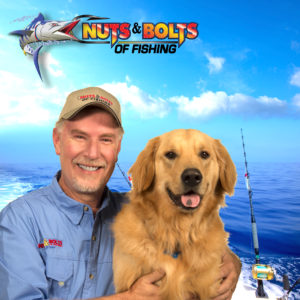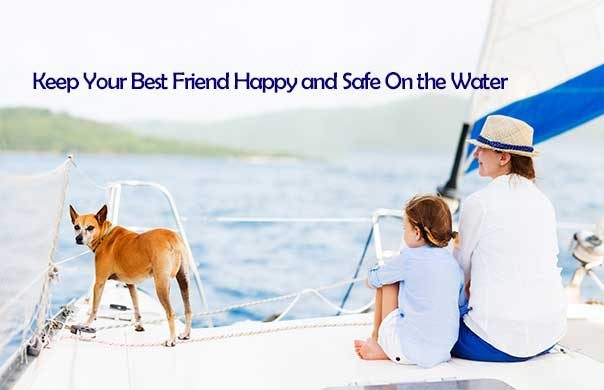Piscatorial Pooches

I once read a survey indicating that at least 90 percent of people who own boats also have at least one dog. Nearly 50 percent of that 90 percent regularly take their dogs along with them on the water. I fall into that category as well. All my dogs have been “boat dogs,” and all of them have loved being out on the water.
Unless you own a cruise ship with plenty of room for your pup to run, there’s really no good place for them to answer “nature’s call.” So before you load the boat, there are a few things to consider prior to putting your pooch on the pontoon. And these are especially noteworthy if this is the first time you’ll be taking your dog out on the water.
Just like us two-legged animals, dogs need clean, fresh water to stay hydrated and happy. Regardless of what kind of beverages you take for yourself, be sure to have plenty of cool (not ice cold) fresh water for your dog. This can be in the form of several bottles of water or even a thoroughly cleaned gallon milk jug with tap water in it. You should know how much water your dog needs during the day, so take 1 ½ times that much along. Don’t expect him to drink it straight from the jug or bottle; have a plastic or rubber-based metal bowl that won’t spill if the boat is rolling a little.
And of course, if you’re going to be out for a while, take them something to munch on. You wouldn’t go out for a day of fishing without a few snacks. Take some doggie snacks for your pup, something that isn’t affected by heat and can be kept in a watertight container. If you plan to be away from home all day, then you need to take a real meal along.
Now the aforementioned items will ultimately result in your pup’s need to relieve himself at some point during the day. Let’s presume that you’ve fed him breakfast and he’s had time to digest and eliminate it, so you’re not immediately facing a bathroom break as soon as you get on the boat. But if you are providing him enough water during the day, he will eventually have to pee. And just like us humans, you can only hold it for so long. Don’t make your pet miserable and induce a mentally bad experience by expecting them to hold it forever. I’ve not seen too many dogs that can simply go over the side, and although I cannot truly verify it, a pup can’t go while they are swimming.
So, what do you do? Well, you plan your day and your destinations such that you have easily accessible pit stops during the day, even if it means pulling up to an island, a beach, or a marina to let your pup relieve itself. And of course, remember all the things you need to do to clean up after your pet. Be aware of leash laws and other regulations wherever you stop. On a normal day, given the conditions described above, I wouldn’t expect my pup to go more than four hours without a pit stop. Neither should you.
Something else we can tend to forget is shade for your pup, and keeping your pup cool in hot weather. Find someplace on the boat that offers a cool shaded place for your dog to lay down comfortably. That hot deck that burns your bare feet is doing the same to his paw pads. Put down a towel, soaked in cool fresh water, for them to lay on.
Unless you own a cruise ship with plenty of room for your pup to run, there’s really no good place for them to answer “nature’s call.” So before you load the boat, there are a few things to consider prior to putting your pooch on the pontoon. And these are especially noteworthy if this is the first time you’ll be taking your dog out on the water.
Just like us two-legged animals, dogs need clean, fresh water to stay hydrated and happy. Regardless of what kind of beverages you take for yourself, be sure to have plenty of cool (not ice cold) fresh water for your dog. This can be in the form of several bottles of water or even a thoroughly cleaned gallon milk jug with tap water in it. You should know how much water your dog needs during the day, so take 1 ½ times that much along. Don’t expect him to drink it straight from the jug or bottle; have a plastic or rubber-based metal bowl that won’t spill if the boat is rolling a little.
And of course, if you’re going to be out for a while, take them something to munch on. You wouldn’t go out for a day of fishing without a few snacks. Take some doggie snacks for your pup, something that isn’t affected by heat and can be kept in a watertight container. If you plan to be away from home all day, then you need to take a real meal along.
Now the aforementioned items will ultimately result in your pup’s need to relieve himself at some point during the day. Let’s presume that you’ve fed him breakfast and he’s had time to digest and eliminate it, so you’re not immediately facing a bathroom break as soon as you get on the boat. But if you are providing him enough water during the day, he will eventually have to pee. And just like us humans, you can only hold it for so long. Don’t make your pet miserable and induce a mentally bad experience by expecting them to hold it forever. I’ve not seen too many dogs that can simply go over the side, and although I cannot truly verify it, a pup can’t go while they are swimming.
So, what do you do? Well, you plan your day and your destinations such that you have easily accessible pit stops during the day, even if it means pulling up to an island, a beach, or a marina to let your pup relieve itself. And of course, remember all the things you need to do to clean up after your pet. Be aware of leash laws and other regulations wherever you stop. On a normal day, given the conditions described above, I wouldn’t expect my pup to go more than four hours without a pit stop. Neither should you.
Something else we can tend to forget is shade for your pup, and keeping your pup cool in hot weather. Find someplace on the boat that offers a cool shaded place for your dog to lay down comfortably. That hot deck that burns your bare feet is doing the same to his paw pads. Put down a towel, soaked in cool fresh water, for them to lay on.
This leads to how to maintain control of your pup when the boat is running or on anchor. Until he has a lot of experience in your boat and truly knows the boundaries of where he is allowed to go and not to go, I would suggest keeping him on a leash. I do not recommend tying the leash to anything in the boat. If you find yourself in an emergency situation, you don’t want your dog going down with the ship.
Similarly, if he is tied to one spot, that could restrict your immediate movement around the boat to take care of an emergency. Remember, you’re bringing the dog along so everyone can have fun. He should not be treated like an inconvenience. If that’s the case, leave them at home or at the pet spa. But, he is also still a dog, so treat him just like you would a 2-year- old child: constantly in sight and under your constant supervision.
If you decide to stop for a swim, don’t immediately assume your pup knows how. It’s best to start him off on the shoreline in knee-deep water and give him time to learn the basics before you toss him overboard in 50 feet of water. A bad “first experience” will only make your pup reluctant to get back in the boat with you.
When you’re teaching your pup to swim, I would suggest getting him a Puppy PFD, which is a comfortable flotation device that fits your dog’s build. Do some shopping and find one that really fits his body shape: It shouldn’t restrict his leg movement, ride up when he’s in the water, or pinch or chafe any body parts. You want him to enjoy having this PFD on.
Here’s a simple fact: Dogs that love to swim will chase down a tennis ball or Frisbee in the water because it’s fun. However, in an effort to please their human counterparts, they will actually swim to the point of exhaustion and drown. So keep an eye on your dog’s swimming ability, be aware of when he is getting tired, and get him out of the water before he gets into trouble. Having a correctly fitted Puppy PFD is a good safety accessory, and it also adds an additional layer of insulation if the water is a little chilly. Furthermore, if the unthinkable should happen while you’re running on plane, then your pup has something to help keep them afloat until you can retrieve him.
For most of us, our dogs are members of the family, whether they’re a duck dog, a show dog or just a loveable companion. And just like any other member of the family, it’s our responsibility to make sure they are safe and comfortable on the water. So before you take Fido on boat, give some serious thought to the things he’ll need out there too. Make it a part of your pre-launch checklist. Your pup will definitely thank you for it.
Tight Lines and Calm Seas

Capt. Cefus McRae is the host of the nationally televised outdoor series “The Nuts & Bolts of Fishing”. The series focuses on providing practical real-world information about fishing and boating from destinations across the southeastern U.S.
Capt. Cefus and his 4-year-old golden retriever Buck the Wonder Dog explore fishy locales from Virginia to the Florida Keys and across the Gulf of Mexico to Texas while showcasing the amenities, attractions and cuisine of the area. Beyond the TV series, Capt. Cefus operates an outfitting service to create memorable outdoor adventures for his clients. When not on the road filming, he and Buck are usually fishing on Lake Lanier or Lake Hartwell in GA.
“The Nuts & Bolts of Fishing” airs on FOX Sports South, FOX Sports Arizona and Alive TV every week, and past episodes can be watched on their website at www.NutsAndBoltsFishing.com




